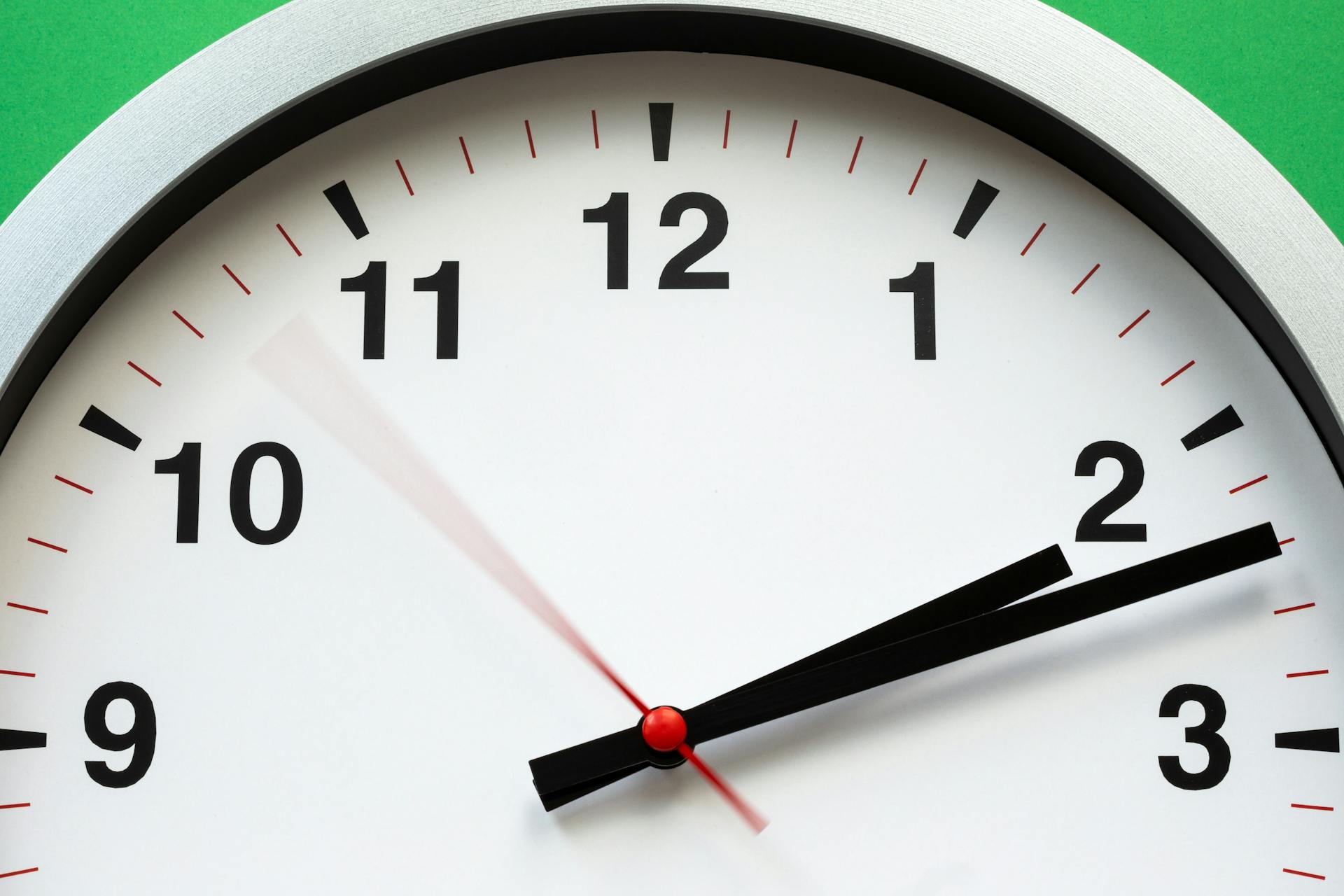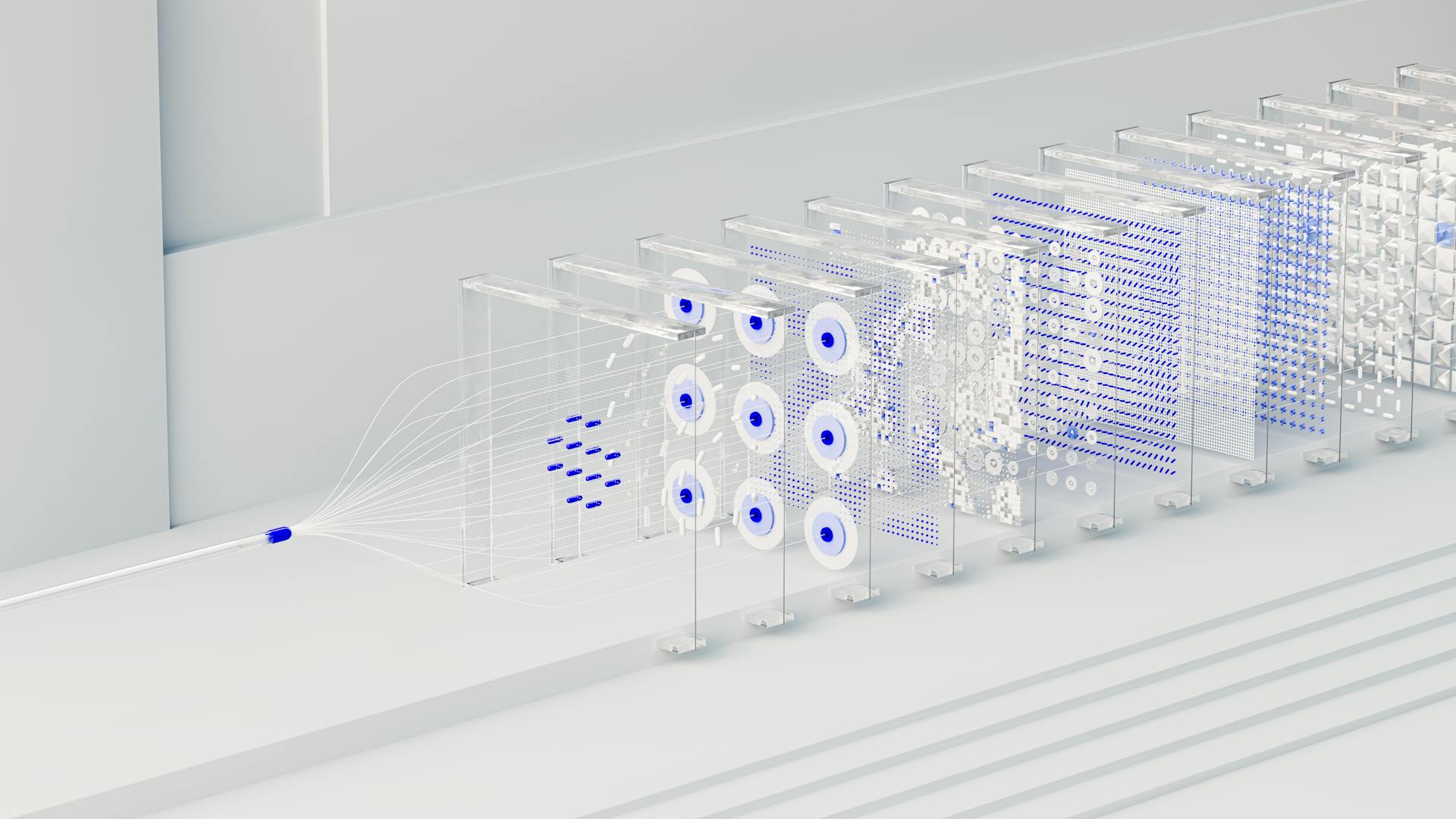
Time series feature engineering is a crucial step in unlocking the full potential of your data. By applying the right techniques, you can transform raw data into meaningful insights that drive business decisions.
One key technique is data normalization, which involves scaling data to a common range. For example, using the Min-Max Scaler, you can normalize data between 0 and 1, making it easier to work with.
Data normalization helps prevent feature dominance, where one feature overshadows others. This is especially important in time series data, where a single variable can have a disproportionate impact on the outcome.
By normalizing data, you can ensure that all features are on the same scale, allowing for more accurate modeling and analysis.
Take a look at this: Outlier Detection in Time Series
Importing Libraries and Data
To get started with time series feature engineering, we need to import the necessary libraries.
The first step is to import pandas, a library that will help us manipulate and analyze our data. Importing pandas is crucial for any data-related task.
We also need to import tsfresh, a library specifically designed for time series feature extraction. tsfresh provides a wide range of features that can be used to transform our time series data into a more useful format.
If this caught your attention, see: Ai Time Magazine
Import Libraries
Importing the necessary libraries is the first step in any data analysis project.
You'll want to import pandas, a library that provides data structures and functions to efficiently handle structured data, including tabular data such as spreadsheets and SQL tables.
Pandas is often used in conjunction with tsfresh, a library that provides efficient and scalable feature extraction for time series data.
This combination is particularly useful for analyzing data with temporal dependencies.
Prepare Your Data
Preparing your data is a crucial step in time series forecasting. You can start by importing the required libraries, including pandas and tsfresh.
To prepare your time series dataset, you'll need to create a sample dataframe. For illustration, let's create a sample dataframe representing different machines recording temperature over time. In this example, id represents different machines, time represents the time points, and temperature represents the recorded temperature values.
You can use pandas to create a dataframe and add columns for date and time features. These features are created from the time stamp value of each observation and can include integer hour, month, and day of week information. You can also add binary features, such as a feature that indicates whether the time stamp information is before or after business hours.
Related reading: Real Time Feature Engineering
Here are some examples of date and time features that can be built:
- Weekend or not
- Minutes in a day
- Daylight savings or not
- Public holiday or not
- Quarter of the year
- Hour of day
- Season of the year
Remember to leverage all date and time properties that you can access from Timestamp or DatetimeIndex when dealing with time series data.
Handling Missing Values
Handling missing values is a crucial step in time series feature engineering. It's essential to address these gaps in your data to avoid biased models and incorrect predictions.
You might encounter missing values after extracting features, and one way to handle them is by imputing them with the mean. This can help maintain the integrity of your dataset and prevent errors in your analysis.
In some cases, imputing with the mean might not be the best strategy, so it's good to have other options up your sleeve. Always consider the nature of your data and the specific problem you're trying to solve before making a decision.
Data Analysis and Extraction
Extracting features from your time series data is a crucial step in feature engineering. This is where you use the ComprehensiveFCParameters class in tsfresh to extract a wide range of features.
The ComprehensiveFCParameters class provides comprehensive feature extraction settings.
To specify the column that identifies different machines, you use column_id="id".
The column that sorts the time points is specified with column_sort="time".
Here's a quick rundown of the key settings for this step:
- column_id="id"
- column_sort="time"
- default_fc_parameters=ComprehensiveFCParameters()
Feature Engineering Techniques
Feature engineering techniques are a crucial step in time series analysis. They help extract relevant information from the data, making it easier to model and predict future values.
One popular technique is rolling feature extraction, which involves extracting features from multiple time windows within the data. This is particularly useful for forecasting tasks, where you want to predict future values based on past behavior.
To implement rolling feature extraction, you'll need to set up the rolling window for your time series data, extract features from each rolling window, handle NaNs, and use the extracted features for forecasting.
Another technique is using lagged features, which involves shifting the values of a variable backward or forward in time by a certain number of time periods. This can help capture temporal dependencies and trends in the data, providing valuable insights and improving the accuracy of predictive models.
In particular, lagged features are useful in predicting future values of a variable, as they can help identify patterns and relationships between variables over time. For example, you can create lagged features like the sales on the prior 1 day and the sales 2 days prior.
Additional reading: Future of Software Engineering with Ai
Expanding window statistics are another technique that consists of features that include all previous data. This can be achieved using the expanding() function in pandas, which provides expanding transformations and assembles sets of all prior values for each timestep.
Here are some common expanding window statistics used in time series analysis:
By using these feature engineering techniques, you can extract meaningful information from your time series data and improve the accuracy of your predictive models.
Tsfresh and Its Usage
Tsfresh is a Python package that automates the extraction of a wide range of features from time series data.
It's designed to handle large datasets efficiently and integrates seamlessly with other data science libraries like pandas and scikit-learn.
Tsfresh can automate the extraction of a vast array of features, saving you time and effort compared to manual feature creation.
The library applies statistical hypothesis tests to determine feature relevance, ensuring the selected features are statistically significant and less prone to overfitting.
To get started with tsfresh, you'll need to prepare your time series data in a suitable format, typically a pandas DataFrame with a time index and relevant columns.
This involves handling missing values and outliers if necessary, which is a crucial step before moving forward.
Here's a step-by-step guide to using tsfresh:
- Data Preparation: Ensure your time series data is in a suitable format, typically a pandas DataFrame with a time index and relevant columns.
- Feature Extraction: Use tsfresh's extract_features function to automatically extract a wide range of features.
- Feature Selection: Employ tsfresh's built-in feature selection methods (e.g., select_features) to identify the most relevant features for your specific task.
- Model Building and Evaluation: Use the extracted features in your machine learning models (e.g., regression, classification) and evaluate their performance.
Tsfresh offers several advantages, including automation, statistical rigor, scalability, and open-source extensibility.
Here are some key benefits of using tsfresh:
- Automation and Efficiency: tsfresh automates the extraction of a wide range of features, saving you time and effort.
- Statistical Rigor: The library applies statistical hypothesis tests to determine feature relevance.
- Scalability: tsfresh is designed to handle large datasets efficiently.
- Open Source and Extensible: The library is open-source, allowing you to customize and extend it to suit your specific needs.
Problem Setup and Validation
We need to set up the problem statement for time series data by loading the dataset and converting the date variable into a DateTime variable using the datetime function in Pandas.
The JetRail dataset has two columns, making it a univariate time series, and we have data for almost 25 months.
To avoid destroying the sequential order within the data, we should carefully build a validation set when working on a time series problem.
Problem Statement Setup
We're working on a time series problem to forecast traffic on JetRail, a high-speed public rail transport, for the next 7 months based on past data.
The dataset is historical and has two columns, making it a univariate time series. The date variable is initially treated as a categorical variable due to its data type being object.
We'll need to convert the date variable into a DateTime variable using the datetime function in Pandas, as it's currently not in a usable format.
The dataset can be loaded and viewed using the print function, specifically with the head function to display the first 10 rows.
Discover more: Create Feature for Dataset Huggingface
Validation Technique
For time series problems, traditional machine learning techniques like randomly selecting subsets for validation and test sets won't cut it. This is because each data point is dependent on its past values, and shuffling the data can lead to training on future data and predicting past values.
We need to carefully build a validation set that preserves the sequential order of the data. This ensures that we're not training on future data and predicting the past.
Curious to learn more? Check out: Ai Engineer Training
To do this, we need to check the duration of our data and decide how much to save for validation. Let's say we have data for almost 25 months. We can save three months for validation and use the remaining for training.
This way, we can ensure that our validation set is representative of the sequential nature of the data, and we can train our models on the remaining data without compromising the integrity of the data.
Domain-Specific Considerations
Understanding the problem statement and available data is crucial for engineering domain-specific features. This includes knowing the end objective and having knowledge of the data.
Having a good understanding of the domain and data can help you create more accurate and fewer features. For instance, if you're forecasting future demands for products, you should consider the store-product combination when creating lag features.
The domain-specific features you create should be based on your knowledge of the products and market trends. This can include pulling external data that adds value to the model, such as weather or holiday data.
For your interest: Android 12 New Features
Domain-Specific #6:
Having a good understanding of the problem statement and knowledge of the available data is essential to engineer domain-specific features for the model.
You can create lag features considering the store-product combination, rather than for the entire data set, which is more accurate.
Having a good understanding about the domain and data helps in selecting the lag value and the window size.
You can use external datasets to include features like the list of holidays, which can affect sales.
The sales can be affected by the weather on the day, so you can use external datasets to include weather-related features.
Having domain knowledge can help you pull external data that adds more value to the model.
Practical Considerations
As you work with machine learning models, it's essential to consider the practical aspects of feature extraction and selection.
Be mindful of the computational resources required for feature extraction and selection, especially when dealing with very large datasets. This can help prevent performance issues and ensure your models run smoothly.
Understanding the meaning of the extracted features is crucial for model interpretation and gaining insights into your data. It's not just about getting the right answer, but also about understanding why the model is making those predictions.
Feature scaling is a critical step in the process, as it ensures that all features contribute equally to the model's performance. This can be done using various techniques, such as standardization or normalization.
Hyperparameter tuning is also a vital aspect of feature selection, and experimenting with different feature sets and hyperparameters can significantly impact model performance.
Efficient Feature Extraction
Efficient Feature Extraction is a crucial step in time series feature engineering. Extracting the right features from your data can make a huge difference in the accuracy of your predictive models.
Using tsfresh, a popular Python library, you can extract a wide range of features from your time series data. The ComprehensiveFCParameters class provides a comprehensive set of feature extraction settings that can be used to extract features such as the day of the week, hour of the day, or month of the year.
Extracting the day of the week is a common example of datetime feature engineering. By creating features such as “day_of_the_week” and “is_weekend”, you can capture the seasonality and temporal patterns in your data. For instance, a time-series dataset of e-commerce sales may have a higher sales volume on weekends than weekdays.
Here are some common features that can be extracted using tsfresh:
- column_id="id" specifies the column that identifies different machines.
- column_sort="time" specifies the column that sorts the time points.
- default_fc_parameters=ComprehensiveFCParameters() uses comprehensive feature extraction settings provided by tsfresh.
These features can be used to improve the accuracy of your predictive models by capturing the temporal patterns in your data. By using the right features, you can build more accurate models that can make better predictions.
Columns
In a time series dataset, each row typically represents a single data point, and we need to understand the different columns that make up this dataset.
The column "id" represents different machines, which is essential for distinguishing between data points from various machines.
The "time" column represents the time points at which the data was recorded, often in a specific format like datetime.
The "temperature" column represents the recorded temperature values, which is the primary focus of our time series analysis.
Each machine's data is uniquely identified by its "id" value, allowing us to track the temperature readings over time for each machine individually.
Understanding the structure of the "time" column is crucial for correctly handling date and time data in our analysis.
The "temperature" column typically contains numerical values, which we can manipulate and transform to extract meaningful insights from the data.
Recommended read: Applied Machine Learning and Ai for Engineers
Sources
- https://medium.com/data-science-at-microsoft/introduction-to-feature-engineering-for-time-series-forecasting-620aa55fcab0
- https://www.geeksforgeeks.org/creating-powerful-time-series-features-with-tsfresh/
- https://dotdata.com/blog/practical-guide-for-feature-engineering-of-time-series-data/
- https://www.analyticsvidhya.com/blog/2019/12/6-powerful-feature-engineering-techniques-time-series/
- https://auto.gluon.ai/stable/tutorials/tabular/tabular-feature-engineering.html
Featured Images: pexels.com


